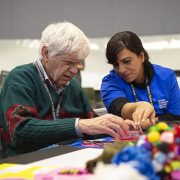Opening the world of cancer research to the low vision community
The Monash Biomedicine Discovery Institute (BDI) in collaboration with the Australian Research Council Centre of Excellence in Advanced Molecular Imaging recently opened its doors to the blind and low vision community with the Sensory Scientific Exhibition and Discovery Day. Held on Friday 6 December, also including students from local primary and secondary schools, and members of the wider community, more than 70 attendees had the opportunity to explore the world of cancer research by engaging with interactive displays and 3D and tactile models.
Conceived by Monash BDI’s Professor Jamie Rossjohn in 2018, this exhibition has grown since it was first held in 2018, travelling across Australia and even included as a finalist for the Eureka Prize for STEM Inclusion.
This year’s exhibition focused on cancer research and was hosted by Professor Roger Daly, the Head of the Monash BDI’s Cancer Program. He said he wanted to host the event because it’s important to engage with everyone in the community in order to explain the mechanisms and treatment of cancer, not just those with normal vision.
“I’ve been in cancer research for 30 years and given hundreds of presentations. However, participation in this event has driven home the importance of communicating our research in a way that is accessible to all,” Professor Daly said.
“We take for granted, when talking to scientists, students and the general public, that they can see what we’re talking about when describing what happens in cancer at a cellular and anatomical level. For those who have low or no vision, using texts and diagrams is often not enough, so programs that can convert these scientific concepts into tactile and audible demonstrations are enormously valuable,” he said.
Dr Erica Tandori, artist-in-residence in the Rossjohn lab, produced a completely new suite of tactile art and models that depict cells and cell division, tumour growth and invasion, standard and new, targeted cancer treatments and more. Dr Tandori has a PhD in visual art and ophthalmology, in which she used art to articulate the processes of her own vision loss caused by juvenile macular degeneration.
“Cancer can affect anyone, even those with low vision. We need to demystify cancer for this community, and this event was a great leveller as it included everyone and related to everyone,” Dr Tandori said.
“We even created a giant tactile chess game for our low vision attendees, , complete with cancer cell chess pieces on one side and immune cell chess pieces on the other. The kids who attended loved playing the game, and they understood that it was at once metaphoric and literal, just as the immune cells try to fight cancer cells in our bodies. It was fantastic to watch them learn and play at the same time,” she said.
Dr Tandori and Dr Kylie Wagstaff coordinated a team of researchers from the Monash BDI Cancer Program to create a range of displays and activities that highlighted the work done across the institute. The exhibition included tactile 3D models, 2D graphic displays, olfactory displays, large print and braille formats, and more than 40 researchers volunteered on the day.
“The exhibition was such a positive experience for all involved. For researchers like myself, it was fantastic to be able to communicate our work in a different way, using models and artwork. The attendees went away with a better understanding of what cancer is and what scientists are doing to try and combat it,” Dr Wagstaff said.
Participants also had the opportunity to experience Monash University’s CAVE2 facility, a 360-degree immersive experience that projected cancer related molecules onto enormous surround-screens.




